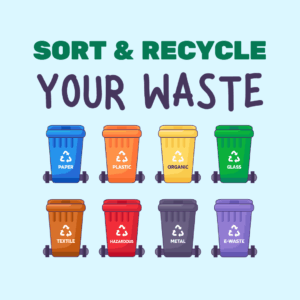Have you ever stopped to think about what happens to all the fabric that doesn’t make it into a finished outfit or where all those unsold clothes end up after a big sale? Behind every stylish piece we love, there’s a pile of waste most people never see. From scraps of fabric and empty dye buckets to old clothes thrown away after a few wears; the fashion industry creates a lot of waste.
But here’s the good news: that waste doesn’t have to end up in dumps or rivers. With the right mindset and systems, the fashion industry can turn “trash” into something valuable; new products, new income, and even new jobs.
If you’re a designer, boutique owner, tailor, or fashion manufacturer (or just starting out in fashion), this post will help you understand what kind of waste fashion creates, how to deal with it properly, and how to follow Kenya’s environmental laws; all in simple, practical terms. Find more posts on environmental laws, sustainability, waste management and everything in between here.
Related post; Fashion’s Waste Crisis: How the Industry Contributes to Solid Waste Pollution
Table of Contents
Fashion Industry Waste and Circular Economy.
Why This Matters
The fashion world looks glamorous on the outside; beautiful clothes, creative designs, glossy photos. But the behind-the-scenes reality is less shiny. Tons of fabric, chemicals, and packaging get wasted every year. When these aren’t handled properly, they end up harming the environment; polluting rivers, soil, and even the air.
In Kenya, things are changing fast. The National Environment Management Authority (NEMA) is now enforcing laws that make producers (that’s brands, factories, and importers) more responsible for the waste they create.
Through the Extended Producer Responsibility (EPR) regulations and the Sustainable Waste Management act, every business, big or small is expected to take care of its waste, recycle what it can, and make sure nothing harmful gets dumped into the environment.
So if you’re in fashion, this is the perfect time to start building your brand in a cleaner, smarter, and more sustainable way.
The Kinds of Waste the Fashion Industry Creates
Fashion waste comes from many stages; from design and manufacturing to what customers throw away later. Here’s a breakdown in plain language:
1. Fabric Scraps and Leftovers
When clothes are cut and sewn, leftover pieces of fabric (called offcuts) pile up. These are often thrown away or burned. If the fabric isn’t separated by type, it’s harder to recycle later.
Example: Those small pieces of kitenge that remain after tailoring, they can actually be turned into patchwork bags, pillow covers, or kids’ clothes instead of being dumped.
2. Dyeing and Printing Waste
When fabrics are dyed or printed, they produce dirty water full of chemicals, colors, and salts. This water (called effluent) is harmful if released untreated into rivers or soil.
Solution: Install or work with an Effluent Treatment Plant (ETP) that cleans the water before release.
3. Chemical and Leather Waste
Leather tanning, fabric finishing, and dry cleaning use chemicals that can be toxic. These wastes must be handled carefully and disposed of by licensed waste handlers.
Tip: Always label and store hazardous waste safely and keep receipts from licensed disposal companies, NEMA might ask for them during inspections.
4. Microplastics and Synthetic Fibers
When synthetic materials like polyester are washed, they shed tiny fibers that end up in water bodies.
Simple fix: Use filters in washing machines, and when designing, choose fabrics that shed less.
5. Old and Used Clothes
Old clothes, whether returned, unsold, or thrown away, form the biggest pile of fashion waste. They often end up in landfills or are shipped overseas as secondhand (mitumba).
Better options: Take-back programs, resale, donations, or upcycling.
6. Packaging and General Waste
From paper tags to plastic wraps and cartons; every item adds up.
Solution: Switch to biodegradable packaging, and separate paper, plastic, and food waste in your workplace.
What the Law in Kenya Says
Here’s what fashion businesses in Kenya should know:
1. EMCA (Environmental Management and Coordination Act)
This is Kenya’s main environmental law. It gives NEMA the power to regulate how waste is handled. Every company must manage its waste properly and avoid pollution.
2. Sustainable Waste Management Act
This policy encourages recycling, reusing, and creating a “circular economy” where materials keep being used instead of dumped.
3. Extended Producer Responsibility (EPR) Regulations
These regulations mean that fashion brands, importers, and manufacturers are responsible for what happens to their products after consumers use them. You’ll need to register with NEMA, join or form a Producer Responsibility Organization (PRO), and report how you handle your waste.
4. Licensing and EIA (Environmental Impact Assessment)
If your factory handles large scale waste, dyes, or chemicals, you must get a NEMA license and possibly do an EIA before you begin operations.
In short: you’re legally expected to know what waste you produce, how it’s handled, and where it goes.
How to Dispose of Fashion Waste the Right Way
Fabric Scraps and Deadstock
- Sort them out: Separate cotton, polyester, wool, and blends, this helps with recycling.
- Reuse or resell: Partner with artisans, upholsterers, or upcyclers.
- Avoid burning: Burning releases harmful gases.
Dirty Water and Sludge
- Treat before disposal: Install an Effluent Treatment Plant (ETP) or work with a licensed one.
- Reuse water: Some systems let you recycle water for washing or dyeing again.
Chemicals
- Store safely: Label every container and keep away from open drains or soil.
- Use licensed waste handlers: NEMA lists approved hazardous waste handlers on their site.
Old Clothes
- Collect them back: Offer customers take-back points in your stores.
- Donate or repurpose: Partner with charities or recycling centers.
- Explore upcycling: Create new items from old clothes (bags, quilts, etc.).
Microplastics
- Install filters: Add filters in washing machines, especially in factories.
- Educate customers: Encourage gentle washing and less frequent laundering.
How to Join the Circular Economy (and Make Money Doing It)
A circular economy means keeping products and materials in use for as long as possible. It’s about designing out waste from the start. Here’s how you can make it work for your business:
1. Design Smart
- Use fewer material types; one-fabric garments are easier to recycle.
- Avoid harmful dyes or finishes that block recycling.
- Create clothes that can be easily repaired or reused.
2. Repair, Resell, or Rent
- Offer repair services or link with tailors who can fix clothes for your customers.
- Try resale programs, vintage and thrift collections are trending globally!
- Rent out high-end or occasion wear instead of selling.
3. Collect and Recycle
- Add a “return and earn” option for old clothes.
- Keep clear records, NEMA may ask for this under EPR rules.
- Partner with local recyclers or upcyclers for sorting and reusing materials.
4. Collaborate and Share
- Join or form a Producer Responsibility Organization (PRO); it’s cheaper and easier to manage waste as a group.
- Work with waste pickers, and recyclers to build a local circular system.
How to Stay Compliant
Here’s a simple checklist:
- Map out all your waste types (fabric, water, packaging, etc.).
- Register with NEMA if you’re a manufacturer, importer, or big retailer.
- Get waste handling or EIA licenses if needed.
- Separate your waste; don’t mix chemicals with normal trash.
- Keep records of how and where you dispose of it.
- Train your staff on good waste practices.
- Work with licensed waste handlers only.
- Join an EPR scheme or PRO once it’s active for textiles.
Why Going Circular Makes Business Sense
Apart from doing the right thing for the planet, circular fashion helps you:
- Save money: By reusing and recycling materials.
- Earn more: By launching resale, repair, or upcycling lines.
- Attract customers: Conscious consumers love sustainable brands.
- Avoid fines: You’ll be on the right side of the law and avoid NEMA penalties.
Common Challenges (and How to Beat Them)
- Blended fabrics are hard to recycle → choose simple, single-fiber materials.
- Recycling seems expensive → join industry groups or PROs to share costs.
- No local recyclers → partner regionally or start small scale local projects.
- Lack of data → start tracking your waste in simple kilograms per month.
What Success Looks Like
You’ll know you’re getting it right when you can track:
- How much waste you reduce or recycle every month.
- How many old clothes you collect from customers.
- How much recycled material you use in new designs.
- Whether you’re registered with NEMA and EPR-compliant.
Easy Wins to Try This Month
- Host a “Bring Back Your Old Clothes” event.
- Use leftover fabric for tote bags or headwraps.
- Add labels showing how to recycle or care for the item.
- Replace plastic packaging with recycled paper or cloth wraps.
Where to Learn More
- NEMA website — for updates on EPR and waste management registration.
- National Sustainable Waste Management Act (2021) — Kenya’s roadmap for recycling and circular economy.
Final Thoughts: Fashion Can Clean Up Its Act
The truth is, the future of fashion is circular not linear. Kenya’s laws are clear: brands must take responsibility for what they produce. But beyond compliance, going circular is smart business. You save money, build customer trust, and protect the planet.
So whether you’re just starting your fashion line or running a factory, start small; sort your waste, learn the rules, and connect with others doing it right. Step by step, we can turn Kenya’s fashion waste into wealth.
And if you’re ready to take action, maybe you want to understand your waste streams better, get help with NEMA registration, or design a circular production model that fits your brand I’d love to help.
As an environmental consultant, I work with fashion businesses in Kenya to:
- Conduct waste audits and mapping
- Help with NEMA licensing and compliance
- Register and report under EPR rules
- Create cleaner, more sustainable production systems
- Develop upcycling and recycling partnerships
📩 Email me at valeriekinoti@gmail.com to start.



